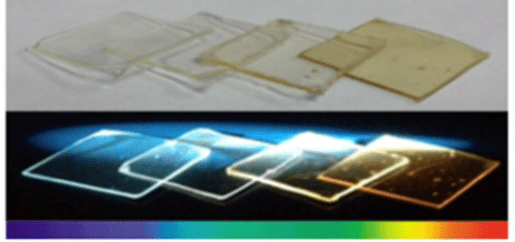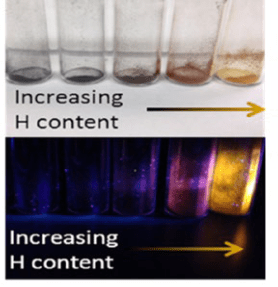Tech Briefs
Savannah River National Laboratory
Carbon Quantum Dots and a Method of Making the Same
Technology Overview
Savannah River National Laboratory has developed a method of preparing a carbon quantum dot. The carbon quantum dot can be prepared from a carbon precursor, such as a fullerene, and a complex metal hydride. The present invention also discloses a carbon quantum dot made by reacting a carbon precursor with a complex metal hydride and a polymer containing a carbon quantum dot made by reacting a carbon precursor with a complex metal hydride.

Benefits
- Environmental stable chromophore that fluoresces at various wavelengths
- Visible to the naked eye
- Extremely low cost and disposable
Applications
- Tunable Fluorescent material for solids state lighting
- Non toxic In vivo application for imaging
- Photovoltaic material for solar applications
Description
Carbon quantum dots have become widely researched due to their low toxicity and good biocompatibility. In addition, carbon quantum dots also possess other desired characteristics such as an adjustable light-emitting range and good photo stability. These carbon quantum dots have been prepared and studied for various applications, including optoelectronics and biomedicine, and have many other potential applications. However, certain methods of preparation are quite expensive and yield carbon quantum dots with undesirable properties. For instance, some of these carbon quantum dots may exhibit a short emission wavelength (e.g., <450 nm), a low photoelectric conversion efficiency, etc. In general, a quantum dot is a material in which excitons are confined in all three spatial dimensions.

Such quantum dots are generally distinguishable from quantum wires and quantum wells. By controlling and/or modifying the size, the chemical modifications, etc. of the carbon quantum dot, various properties (e.g., optical, chemical, electrical, etc.) can be controlled.
As a result, there is a need to provide an improved method of preparing carbon quantum dots. In particular, there is a need to provide a method of preparing carbon quantum dots that allows for the ability to control or tune the properties, such as the photophysical, electronic, and/or quantum confinement properties.
Intellectual Property
The technology has been granted US Patent No. 9,738,827 (August 22, 2017), “Carbon quantum dots and a method of making the same.”
Partnering Opportunities
SRNL invites interested companies with proven capabilities in this area of expertise to develop commercial applications for this process under a cooperative research and development agreement (CRADA) or licensing agreement. Interested companies will be requested to submit a business plan setting forth company qualifications, strategies, activities, and milestones for commercializing this invention. Qualifications should include past experience at bringing similar products to market, reasonable schedule for product launch, sufficient manufacturing capacity, established distribution networks, and evidence of sufficient financial resources for product development and launch.
Download Tech Brief
Contact Information
Savannah River National Laboratory
E-mail: partnerships@srnl.doe.gov